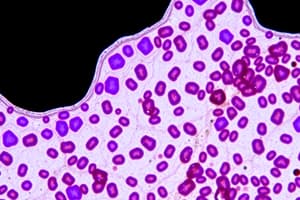Podcast
Questions and Answers
Within the historical context of evolutionary developmental biology, the scala naturae, conceptualized by pre-Darwinian philosophers, is most accurately characterized as:
Within the historical context of evolutionary developmental biology, the scala naturae, conceptualized by pre-Darwinian philosophers, is most accurately characterized as:
- A rudimentary phylogenetic tree positing common ancestry and divergent lineages based on observed morphological gradations.
- A cyclical representation of natural transformations, devoid of hierarchical structure, focusing on ecological interdependence and functional adaptation.
- A linear hierarchical model arranging organisms from simplistic to progressively complex forms, culminating in anthropocentric placement. (correct)
- An early iteration of cladistics, emphasizing shared derived characteristics to delineate evolutionary relationships among species.
The principle of parallelism, championed by Meckel and Serres, posited a specific relationship between ontogeny and the scala naturae. Which statement most precisely encapsulates this relationship?
The principle of parallelism, championed by Meckel and Serres, posited a specific relationship between ontogeny and the scala naturae. Which statement most precisely encapsulates this relationship?
- Individual development directly mirrors the evolutionary progression through adult forms represented in the scala naturae.
- The complexity of developmental pathways decreases proportionally to an organism's position on the scala naturae.
- Ontogenetic stages transiently exhibit embryonic features reminiscent of ancestral species occupying lower rungs on the scala naturae. (correct)
- Phylogenetic relationships are exclusively determined by analyzing homologous embryonic structures across the scala naturae.
Ernst Haeckel's biogenic law, succinctly expressed as "ontogeny recapitulates phylogeny," is best interpreted, within the context of 19th-century evolutionary thought, as:
Ernst Haeckel's biogenic law, succinctly expressed as "ontogeny recapitulates phylogeny," is best interpreted, within the context of 19th-century evolutionary thought, as:
- A rigorous, empirically validated framework for reconstructing phylogenetic relationships solely based on detailed analysis of embryonic developmental sequences.
- An early formulation of heterochrony, specifically emphasizing acceleration as the primary mechanism driving evolutionary change in developmental timing.
- A proposition that the developmental trajectory of an organism replays the adult morphological stages of its ancestral lineage. (correct)
- A nuanced perspective acknowledging von Baer's critique while retaining the core tenets of parallelism through modified embryological interpretation.
Karl Ernst von Baer's embryological laws directly challenged Haeckel's biogenic law by asserting that:
Karl Ernst von Baer's embryological laws directly challenged Haeckel's biogenic law by asserting that:
Von Baer's hypothesis regarding the evolutionary conservation of early developmental structures is primarily attributed to:
Von Baer's hypothesis regarding the evolutionary conservation of early developmental structures is primarily attributed to:
The advent of the modern synthesis in evolutionary biology significantly reoriented the study of evolution and development by:
The advent of the modern synthesis in evolutionary biology significantly reoriented the study of evolution and development by:
Heterochrony, a core concept in evolutionary developmental biology, is most precisely defined as:
Heterochrony, a core concept in evolutionary developmental biology, is most precisely defined as:
Paedomorphosis through progenesis, a specific type of heterochrony, is characterized by:
Paedomorphosis through progenesis, a specific type of heterochrony, is characterized by:
Neoteny, another form of paedomorphosis, is distinguished from progenesis by:
Neoteny, another form of paedomorphosis, is distinguished from progenesis by:
Recapitulation via hypermorphosis, in the context of heterochrony, is best described as:
Recapitulation via hypermorphosis, in the context of heterochrony, is best described as:
Research on gene expression in primate prefrontal cortex development reveals evidence of neoteny in humans primarily through:
Research on gene expression in primate prefrontal cortex development reveals evidence of neoteny in humans primarily through:
Comparative studies of central complex (CX) development in Drosophila melanogaster and Tribolium castaneum have demonstrated:
Comparative studies of central complex (CX) development in Drosophila melanogaster and Tribolium castaneum have demonstrated:
The observed acceleration in the development of certain neuron clusters within the central complex of Tribolium castaneum, compared to Drosophila melanogaster, is hypothesized to be adaptively linked to:
The observed acceleration in the development of certain neuron clusters within the central complex of Tribolium castaneum, compared to Drosophila melanogaster, is hypothesized to be adaptively linked to:
Sequence heterochrony, as exemplified in the comparative development of the insect central complex, fundamentally implies:
Sequence heterochrony, as exemplified in the comparative development of the insect central complex, fundamentally implies:
The central complex (CX) in insects, as highlighted by evo-devo research, is functionally most critically associated with:
The central complex (CX) in insects, as highlighted by evo-devo research, is functionally most critically associated with:
Considering the historical progression of evo-devo thought, how does Haeckel's biogenic law relate to the earlier concept of parallelism?
Considering the historical progression of evo-devo thought, how does Haeckel's biogenic law relate to the earlier concept of parallelism?
Which pair of heterochronic processes, among the four types described, directly represent opposing alterations in somatic developmental timing while maintaining reproductive timing constancy?
Which pair of heterochronic processes, among the four types described, directly represent opposing alterations in somatic developmental timing while maintaining reproductive timing constancy?
If a hypothetical species were to exhibit paedomorphosis primarily through neoteny, which set of developmental and life-history traits would most likely characterize this species relative to its ancestors?
If a hypothetical species were to exhibit paedomorphosis primarily through neoteny, which set of developmental and life-history traits would most likely characterize this species relative to its ancestors?
In a hypothetical evolutionary scenario where sequence heterochrony results in a crucial predator avoidance developmental stage being significantly delayed in ontogeny, what would be the most probable ecological and evolutionary consequence for the affected species?
In a hypothetical evolutionary scenario where sequence heterochrony results in a crucial predator avoidance developmental stage being significantly delayed in ontogeny, what would be the most probable ecological and evolutionary consequence for the affected species?
Synthesizing the research findings on heterochrony in brain development across primates and insects, which overarching evolutionary trend regarding developmental timing in complex neural structures emerges as most consistently supported?
Synthesizing the research findings on heterochrony in brain development across primates and insects, which overarching evolutionary trend regarding developmental timing in complex neural structures emerges as most consistently supported?
Flashcards are hidden until you start studying




